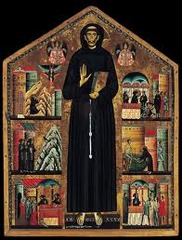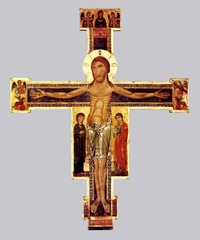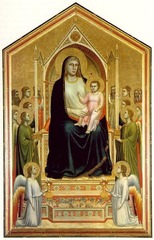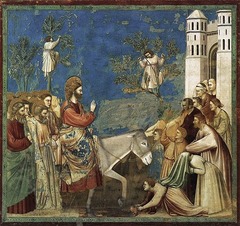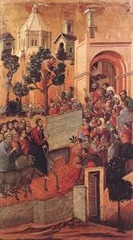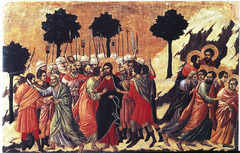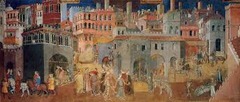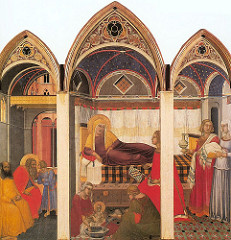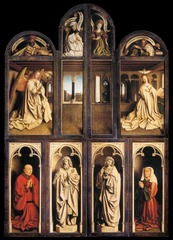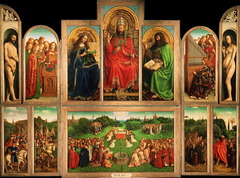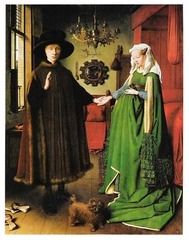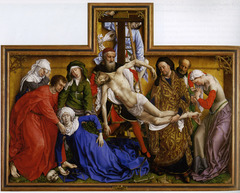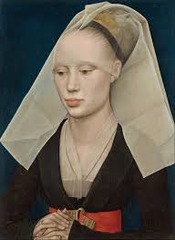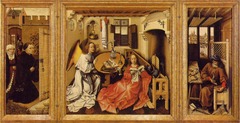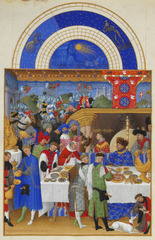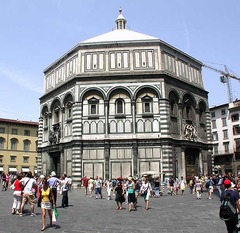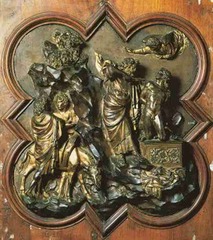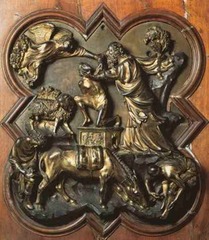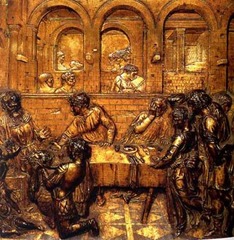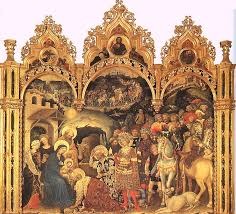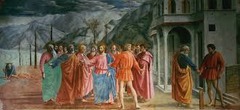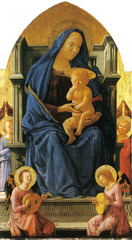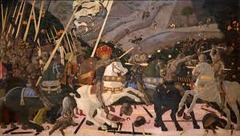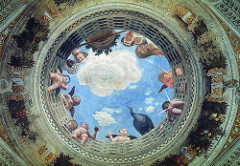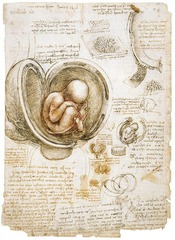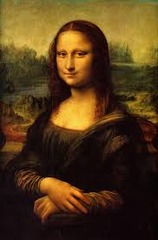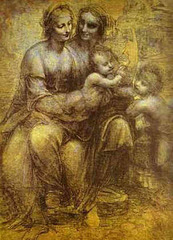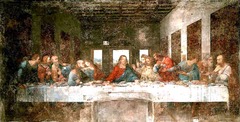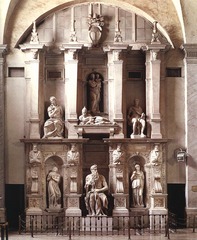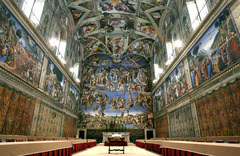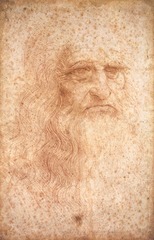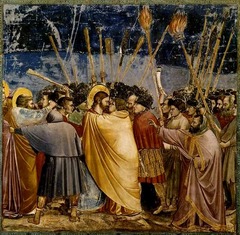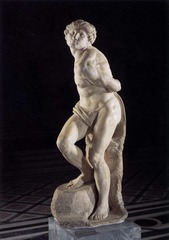“St. Francis Alter Piece” Berlinghieri, de-emphasis on human form, proto-renaissance, Stigmata, miracle preformed to heal legs, Italy
“Jesus on the Cross” Berlinghieri, Italy, not a crucifixion, virgin mary and st. John present, eagle, ox, lion and angel represent the apostles
“Madonna Enthroned with Angels and Prophets” Cimabue. Proto-renaissance, Florence. Everything is flat, maesta, doesn’t have weight that occupies space in a realistic way
“Madonna Enthroned” Giotto. Proto-renaissance, Florence, Mary has weight and occupies space, chiaroscuro, actually baby used as model
“Flight into Egypt” Arena Chapel, Giotto, Florence, proto-renaissance, fresco paintings, strong centralized image which is important in renaissance art, use of line is to keep focus on Mary and Jesus
“The Crucifixion of Jesus” Giotto, Arena Chapel, proto-renaissance, Florence, fresco, Jesus is dead, ground cracked open and skull is shown to denote judgement day, Man with halo gave Mary a tomb for jesus
“Entry into Jerusalem” Giotto, Arena Chapel, proto-renaissance, florence, fresco, shows humanism with man getting shirt stuck over head, placing clothes down for donkey to walk on
“Entry into Jerusalem” Duccio, Sienna, less emphasis on humanism, yearbook stacking of people
“Lamentation” Arena Chapel, Giotto, Florence, buon fresco, presence of boldly foreshortened angels, Pietá, Giotto’s characters show convincing human emotions
“Maesta” Duccio, Sienna, overlapping used to show depth, softening of figures and showing of individualized face of four saints kneeling, folds of garments fall and curve loosely, proto-renaissance
“Betrayal of Jesus” Duccio, Siena, Peter cuts off ear, background with rock formation is traditional, bodies have mass, chiaroscuro, draperies are convincing, figures reaction to central event, humanism is shown, proto-renaissance
“Annunciation” Martini, Siena, Gabriel telling mary, lilies between them, weightless figures, spaceless settings, wings still beating, gold gown because he came from heaven, mary looks worried
“Effects of Good Government in the City” Ambrogio Lorenzetti, secular, represents the turbulent politics during the time, proto-renaissance
“Birth of the Virgin” Pietro Lorenzetti, Siena, proto-renaissance, middle class house in Siena displayed
“The Florentine Duomo” Florence Cathedral, bell tower is uniquely italian, Giotto designed bell tower, Brunelleschi is architect of dome who wanted a hemisphere but ended up with an elliptical double shell dome because of preexisting structure.
“Ghent Altarpiece” Closed, Hubert and Jan van Eyck, Flemish (Flanders/Belgium), anunication scene on top, Mary’s purity denoted with copper kettle and niche separating her and gabriel, dove=holy spirit, white cloth also denote purity. On bottom, two figures in white are saintly and in red are donors, fur collar suggesting wealth.
“Ghent Altarpiece” Open, Hubert and Jan van Eyck, Flemish (Flanders/ Belgium), lamb ontop of alter symbolizes sacrifice of jesus, angels holding crown of thorns and nails is symbolism of the passion, skirt of blood from the lambs breast to a chalice symbolizing the body and blood of christ. transubstantiation takes place (bread and wine). Jesus is wearing red to connect to the sacrifice, jesus is wearing the papal tiara. Mary is reading a book as if at annunciation. John the Baptist is at his right (his death was seen as a pre warning of jesus’). Detailed and individualized portraiture typical in Flemish portraiture.
“Giovanni Arnolfini and His Wife” Jan van Eyck, Flemish, Italian banker who was leaving his wife at home, contractual agreement between them that she would take care of his stuff and be faithful. The backs are recorded in the mirror and van Eyck signed “van Eyck was here”, dog represents faithfulness, can see Jan in mirror, shoes off suggest oath is being taken on sanctified ground, Patron St. Margret of domesticity on the headboard, symbolism masquerading in normal objects is very Flemish.
“The Man in the Red Turban” Jan van Eyck. Flemish, individualized, possibly idealized, bust length portraits, self portrait, first painting in western culture where sitter looks directly at viewer
“The Deposition” van der Weyden. Specific moment when jesus is taken down from the cross, St. John the Younger in red taking care of Virgin Mary, Mary Magdalen at the feet of jesus, continuous linear progression/repetition of shape. Flemish
“Portrait of a Lady” van der Weyden. hands are weird and squished at the bottom, Flemish. Bust length portrait
“Mérode Altarpiece” Campin, main part is annunciation, Flemish, in the process of kneeling suggesting movement, candle has just blown out, naked baby holding a cross flying on a beam of light, baby coming in but not breaking window symbolizing virgin birth, donors on left, Joseph on right (shown as old carpenter), shape of vase is womb like. Middle renaissance
“Les Très Riches Heures du Duc de Berry” January. Limbourg Brothers. From Netherlands moved to paris, created for Duke. Secular. Theme is activities that occur during certain months of the year.
“Baptistry of Florence” characteristic florentine façade: green and white marble, set of bronze doors (defines beginning of early renaissance) emergence of ownership of fame begins when competition panels are submitted
“Sacrifice of Isaac” Lorenzo Ghiberti. Emphasized grace and smoothness, needed to include systemic quatrefoil frame, much more diagonal, going to stab isaac, the moment hasn’t happened just yet, angel doesn’t stop him. Ghiberti won because he used the idyllic classical nude figure, and because of his extraordinary portrayal of the moment. Florence saw themselves as Isaac after Milan’s Duke dies of plague before destroying them in war. Early renaissance. Commission on the next baptistry doors “Gates of Paradise”
“Sacrifice of Isaac” Brunelleschi, Florence, architect of Duomo, hand around Isaacs neck, knife in other hand, angel has to stop Abraham, his extras have a lot more of the scene. Early renaissance
“Gates of Paradise” Ghiberti, after winning competition. large square gold frames, great sense of depth, 2D sculpture. High middle and bas relief used to denote depth. Early renaissance. Florence
“Saint Mark” Donatello, Florence. 3d sculpture designed to be in niche, body position uses contrapposto (weight shift principal, using the mold of a grecian statue), drapery: roman inspiration conveys the sense of the body, drapery corresponds to body underneath. Early renaissance
“David” Donatello, florence, relaxed contrapposto, idealized to look like a greek god, early renaissance because humans can accomplish things but with divine intervention, closed form, david has slain goliath because his hair hasn’t been cut (12), divine intervention shows through his giant sword
“Feast of Herod” Donatello. Siena, uses linear perspective with arches denoting a background, bronze relief, early renaissance, John the Baptist’s head is presented on a plate, humanism shown with man leaning back in disgust but also peeking through his hands at the scene.
“Adoration of the Magi” Gentile da Fabriano, Florence, 3 magi present, they look like they stepped out of a royal court, looks like whole town came to worship, the detailings draw comparison to Flemish paintings. Early renaissance
“Tribute Money” Masaccio. Florence, early renaissance, frescos that decorated church walls, looks more like giotto. Simplicity with concentration on form, individuality and specific emotion captured. Repetition of figures to show passage of time. Figures have weight and they occupy space. Atmospheric perspective utilized. St. John the younger is idealized. St. Peter and the tax collector are shown moving through multiplicity.
“Virgin and Child” Masaccio. Maesta, has weight and occupies space, versus Giotto he advances the style (baby actually looks like a baby.) Mary is looking off in the distance to create a multiplicity of meaning in her face. Grapes symbolize wine in baby jesus’ hands. Baby isn’t offering a sign of blessing but instead acting like a real baby. Early renaissance.
“Expulsion of Adam and Eve from Eden” Masaccio, Florence, Early renaissance, cast into barren landscape, lines represent voice of god. They have weight and occupy space, Chiaroscuro, Adam is feeling consciously bad (holding his head), while eve is instinctually covering her body (physically tormented).
“The Holy Trinity” Masaccio, Florence, early renaissance, involves a crypt behind a fresco, served as an alter piece (alter slab pictured above burial). Jesus is on the cross, God is holding the cross, and the dove above jesus’ head and god’s represents the holy spirit. Mary and St. John at feet. Donors below outside space of chapel. One point linear perspective used (all lines converge in a triangle behind god’s head, vanishing point is at foot of the cross.)
“Battle of San Romano” Middle Renaissance, Florence, Paolo Uccello. Foreshortening, battlefield shows clashing of wooden spears that fell to ground in intentional grid pattern (Della Pittura: Alberti utilized),
“The Hunt” Paolo Uccello, Middle Renaissance, Florence
“David” Andrea del Verrocchio, Middle Renaissance, Florence, less divine intervention shown David is now around 15, denoted by short hair, lean body but some masculinity shown. Donatello’s David is looking down (realizing it was a miracle), this david looks proud 50/50 divine intervention.
“Birth of Venus” Sandro Botticelli. Retelling of Greek Myth of Venus being born out of the sea foam and sailing to shore on seashell. Nymph figures blowing her to sea. Contrapposto. Artist from Middle renaissance emphasize line. Botticelli is interested in edges (harsher and flatter effect, often have a harsh sculptural feel). Florence
“Primavera” Botticelli (Midichi patronage) Middle Renaissance, florence, companion pieces, fancy arrangement of images that have some sort of complex iconography that we don’t know. “The Three Graces” group of three women from classical times which is actually the same woman repeated to symbolize the entirety of line.
“Young Man Holding a Medal” Botticelli, Middle renaissance, Florentine man, the coin has the father of Florence on it, use of chiaroscuro, obscured lines typical portrait format is profile. “Simon Vespucci” hands look really condensed into frame
“Madonna and Child with Angels” Fra Filippo Lippi. Maesta, halo is in place of crown, things look really flat because of excessive lines, middle renaissance, florence, landscape is used to denote 3D
“Foreshortened Christ (Dead Christ)” Andrea Mantegna. Blur between middle and high renaissance but this is middle renaissance since they love line, Milan, body is obviously very foreshortened, first thing you see is holes in feet, a lot of detail is put into the shroud of turin which is heavily geometric.
“Painted Chamber of Camera Spoci” Mantegna, Italy, puts viewer directly into center of painting, secular, foreshortened angels, cupid figures connected with the idea of love. Peacock is associated with Hera (Goddess of marriage). Middle renaissance
“resurrection” Piero Della Francesca, middle renaissance, Tuscany, The moment jesus steps out of his sarcophagus, looks like a triumphant soldier, classicism seen in jesus’ body, foreshortened figures at the bottom, triangle used as favorite compositional device to draw eye to center, barren trees on left, rebirth signified on right.
“The Christ Giving the Keys to Peter” Perugino. 1 point linear perspective, not a lot of depth, uses scale to suggest distance, uses atmospheric perspective. Rome, middle renaissance
“Vitruvian Man” High renaissance, Leonardo Da Vinci, Italy, string-theory type of structure (this drawing combines geometry, architecture and art among many other things.) Da Vinci was probably a deist and thats why we saw a deemphasis on divine intervention.
“The Fetus and the Lining of the Uterus” Leonardo Da Vinci, high renaissance, tried to capture emotion in an exaggerated way. Very interested in psychology. Italy
“Madonna of the Rocks” Leonardo Da Vinci, Milan, high renaissance, virgin mary with jesus and john the baptist. Very humanized, mary is depicted just as a mother and not the queen of heaven. Botanist, plants are all from real life, multiplicity of meaning within smile but sad eyes, angel represents god sayings “This is foretold”, Sfumato (all edges are blurred).
“Mona Lisa” Da Vinci, high renaissance, wife of wealthy banker in florentine, half length with 3/4 turn as if she is open to conversation but she controls the relationship (psychologically important), hands are importantly included because hands are used to communicate, uses atmospheric and landscape to lead your eye up winding path, rejects anything linear, face is ambiguous so viewer takes away her emotion based on their own emotions.
“Madonna and Child with Saint Anne” St. Anne is Jesus’ Gma, Jesus is reaching for lamb and virgin mary looks like she’s pulling him away. Lamb signifies sacrifice. We don’t know if she’s pulling away or letting go, looking back as a kid or in comfort. Symbolism made real. Italy, high renaissance. Da Vinci
“Madonna and Child with St. Anne and Infant St. John” St. John is the baby as well with Jesus (Jesus is holding his fingers up in a position of blessing), he humanizes the characters. Da Vinci
“The Last Supper” Da Vinci, Milan, High Renaissance. Leonardo went after this commission and got it, in the dining room of a home for priests. A very humble environment, the simplicity of it provided something for ordinary men to meditate to while they ate their humble meals.
-changed the course of portraiture, becomes the gold standard for how the last supper is represented for a long time.
-Jesus is giving the bread and wine as the body and blood. Parenthetical figures used. Triangle implemented, one point linear perspective, all points converge behind jesus’ head, horizontal as table, dialogue can be pinned on each character. Light is used heavily judas is close to jesus to show the real betrayal, his face is in shadow while everyone else is in light. Mouth was originally open to denote talking. Angry hand and calm hand.. human emotion.

“The Pietá” Michelangelo, florentine sculptor, (when virgin mary is holding jesus in mourning it is called a pieta.) Moves to Rome for the money after being commissioned by wealthy cardinals. Pope julius the 2nd employs him for sistine chapel. Virgin Mary is apex of the triangle, her body underneath jesus expands to accommodate him which is disproportionate. extraordinary technique, an incredible ability to create textural contrasts between porcelain like flesh and heavy drapery. Dominant feature is the drapery. Across Mary’s bodice there is something that looks like a sash, the sash presses down on the fabric of the bodice to denote a lighter drapery in the bodice area. Sash has his name on it, at the very end of the sash it says “Florence.” It is huge that he can display his name on the bodice of a Virgin mary. It was so spectacular that people thought he couldn’t have done it alone at such a young age, that is why he carved his name and hometown in it. Ownership of work is a very renaissance thing (pride is a sin this is why we don’t see it in the middle ages)
“David” Michelangelo. Rome. David has grown; classicized. In ancient Greece the men would serve in the army from 18-24. When you look at his body it is believable; with his body he could defeat goliath without God. He looks confident/proud. It is before; there is no sword or head shown. He looks really proud from the front but a close up of his face we can see him feverishly sizing up his opponent. Humanization of David is shown with the curling of the hand and the emotion in his eyes as the viewer gets close enough. His anxiety is relatable. Michelangelo chooses to give david unrealistically/unproportionally large hand to emphasize that he still has room to grow. It also concentrates our focus on his hand and head, representing that intellect and the physical capability coming together perfectly at the same time.
“The Tomb of Pope Julius II” Michelangelo. Rome. Pope Julius the second wanted to Michelangelo to create a tomb for him. Looks like a pyramid, it will be in the crossing square of old st. peters #1 pilgrimmage site of christiandom. Julius dies before the tomb is completed; the new pope wants Michelangelo to work for him. The freestanding structure turns into a glorified wall relief in the building that is on the outskirts of Rome. The most important figure is that of Moses in the center (supposed to be an effigy of St. Julius.)
“Moses” from the Tomb of Pope Julius II, Michelangelo. Rome. High Renaissance. -the proportions of Moses are weird because he is carved to be seen from below as it would have been at the top. We see the classic manipulation of proportions to denote narrative implications.
-Michelangelo’s form in sculpture is unparalleled, narrative trumps form for him though, even though we know his sculpture is the best around. In the case of moses, it is more important for him to give us a sense of who this prophet was than whether the form is working exactly perfectly. The problem in this is the narrative he is trying to capture.
“Sistine Chapel” Michelangelo. Rome. High renaissance.
-Michelangelo didn’t want to do it, he was bullied into it because he couldn’t finish the tomb, he had physical ailments (pinched nerves/herniated discs, fell off a scaffold and almost died), he said to Julius “I’m not a painter” and Julius made him figure it out, and that is what he did. Breaking them down into frames is what made it less scary to him. He worked from end to end. In the earlier ones they are cramped with a lot of figures and someone looking up cant appreciate the form.
“The Creation of Adam” Michelangelo, sistine chapel, rome. fingers just about meeting but not yet meeting “most famous void space in the history of art” an allusion to middle renaissance where the completion of the action has not taken place yet. When god touches that finger, adam will be infused with a soul and he will be whole. The two clear figures: the woman is Mary, and the baby is jesus. This is to show that God knows how everything is going to play out. We accept god as omnipotent, so it would make sense that Mary is in the wings even before Mary is created. God’s hand is on Jesus’ shoulder. He shows this to shows God’s accountability; he is infinitely benevolent but also infinitely evil. Michelangelo has a tortured complex of his religion.
“Garden of Eden” Sistine Chapel. Michelangelo, Rome. High Renaissance
-Passage of time shows the temptation and expulsion from the Garden of Eden. The head of the demon that is tempting them is the same head as the angel who is throwing them out of the Garden of Eden as the word of god. Did god set them up by tempting them in the first place then throwing them out.
“Self-Portrait” Leonardo Da Vinci. 3/4 turn, red chalk on paper, solemn eyes looking away not capturing the viewer. High Renaissance
“Kiss of Judas” Giotto, Arena Chapel, florence, proto-renaissance. Inconsistent field of blue in the background, judas about to kiss jesus, jesus looks angry but calm, jesus’ body is lost under judas’ shawl, Peter is in the act of literally cutting the ear off.
“Ospedale degli Innocenti (hospital of the Innocents)”
Filippo Brunelleschi
Florence
Early Renaissance
Designed as a children’s orphanage and it regarded as a prime example of early italian renaissance architecture. Revival of classical style, composite order. It’s coloring is reminiscent of the Baptistry of florence.
“Slave”
Michelangelo
Rome, High Renaissance
Violent contrapposto recognized, for the tomb slaves were utilized to denote attitudes of revolt and exhaustion.
“St. Peter’s Basilica” Vatican city, high renaissance. St. Peter’s burial sight. Architects: Numerous but Michelangelo and Giacomo della Porta worked on the dome.
